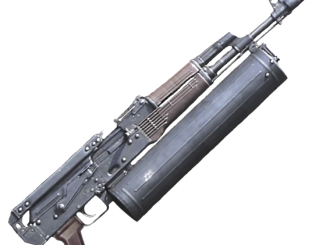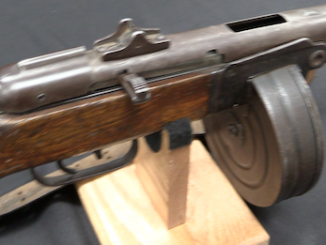The Type 68 is a North Korean hybrid of the Tokarev and the High Power, used as a military service pistol until replaced by the Beak-Du-San copy pop the CZ75. The general outline of the gun is a copy of the Tokarev, with a modular removable fire control group, lack of manual safety, and tall thin sights. It is chambered for 7.62x25mm, and uses a magazine identical to the standard Tokarev except for not having a magazine catch cut, as the Type 68 has a heel magazine release.
Internally, the High Power elements include a detent-retained barrel pin, use of a solid barrel cam instead of a 1911/Tokarev swinging link, and a fixed barrel bushing. Two patterns of markings exist, one with a date and North Korean marking, and one (like this example) with only a serial number.
North Korean guns of all types are very rare in the United States. A very small number of Type 68s have come into the US, generally through Central America (probably via Cuba) and South Africa (via Rhodesia/Zimbabwe).
Update: It appears that the original design work for these was done by an independent engineering firm in Yugoslavia. The design (a TT33 with High Power type locking and angled slide serrations) was not completed in time for the trials that would lead to adoption of the Yugoslav M57, and the drawings were transferred to “another country” – probably North Korea.
Thanks to Legacy Collectibles for loaning me this pistol for filming!




“A very small number of Type 68s have come into the US, generally through Central America (probably via Cuba) and South Africa (via Rhodesia/Zimbabwe).”
Did DRPK sent them as aid, sell them (get paid) or both (aid in once case, sell in another)?
https://digitalarchive.wilsoncenter.org/document/118093
The late Fidel Castro Ruz in a memorandum of conversation to Angolan MPLA president José Eduardo dos Santos on 8 Sep. 1986 discussed how, with the 1980 election of POTUS Ronald Reagan and officials like Alexander Haig, etc. that the threat of war between the United States and Cuba, or a regional Central American/ Caribbean conflagration–Guatemala, El Salvador, Nicaragua, Cuba, Grenada, etc. forced the MININT and MINFAR to reconfigure national defense. With membership in the
Warsaw Pact not an option, and the Soviets unwilling to ship enough weapons deemed necessary (1.5 million small arms) to equip the Milicias de Tropas Territoriales or MTT, the Cubans turned to other suppliers. From the Memcon: “At the end of the Second Congress [of the PCC, Dec. 1980], when Regan was president-elect, … we asked Chernenko, who had attended the Congress, for the first weapons for th MTT. We asked him for half a million weapons. [These came, free of charge from the USSR]. “We had to buy arms from everyone, from Poland, Bulgaria, Yugoslavia [a neutral, non-aligned nation], [DPRK] Korea. … Some gav us weapons for free, Bulgaria … also the GDR … Poland sold them to us at a very low price … Yugoslavia, a little more expensive … and we are grateful, because we needed the weapons.” 100,000 Kalashnikovs from DPRK: “They gave them to us at cost and offered very good terms of payment.”
You may recall the incident a few years ago where a Cuban ship was boarded in Panamá because it was carrying aircraft and missile parts …
Decent gun that “dear leader” fact.
to me the slide looks more like a standard 1911 slide than the high power slide. the innards are pure tokarev, though. the trigger group is probably superior to a 1911, depending on quality of build. interesting pistol.
Where’s the CLOSED CAPTIONS?? 🙁
Watch on Youtube
https://youtu.be/50OZ9fmiOFs
Thanks but it’s not captioned on YouTube either.
It is the dots in the top right and select the caption language
Earlier there were. Maybe some YT issue?
“(…)North Korean hybrid of the Tokarev and the High Power(…)”
Comparison with K14-VN is interesting:
https://modernfirearms.net/en/handguns/handguns-en/vietnam-semi-automatic-pistols/k14-vn-eng/
this automatic pistol has double column magazine, with capacity 13. I do not know if it was directly inspired by High Power, but as last inspired others to implement double-stack in service automatic pistols, it is at least indirect inspiration.
It is interesting that whilst in DRPK it was decided to copy locking system, but retain magazine virtually unchanged, in Vietnam it was opposite – left locking system as is, but implement high-capacity magazine.
Best interpretation of T33 I have seen yet. Simple and common sense pistol, free of Russian baroque.
Belarussian footie is great.
https://en.m.wikipedia.org/wiki/The_Prince_and_the_Pauper
Keep in mind that F.V.Tokarev himself worked at improved TT-33 variant, see 5th image from bottom here: http://historypistols.ru/blog/pistolety-pod-unitarnyj-patron-avtomaticheskie/opytnye-obrazcy-pistoletov-tokareva/
it had capacity 15, thicker grip (width 42 mm) and different magazine release (see photo). ~1000 examples were made
The copy of the CZ-75 is named after Paektu-San (San = mountain in Korean). Mount Paektu is considered by some to be the spiritual birthplace of the Korean people and North Korean propaganda has always held that Kim Jong Il was born on Mount Paektu during Kim Il Sung’s revolutionary struggles against the Japanese occupation forces. Most scholars believe he was probably born in Soviet Russia. As far as Kim Jung Il personally directing adoption of the Paektu-Dan pistol, it’s a long-standing practice of the NK state media to ascribe all important or successful decisions to whichever Dear Leader Kim is in power during one of his omniscient “on the spot guidance” trips. It’s key to building the cult of personality. Keep up the great videos!
That looks like it might be a very good pistol. There’s even enough metal left below the trigger for a bubba transplant of a hi power mag release button.
The slide really does look like a Hi Power, and (IMO) the Tok removable feed lips and “fire control” are probably still among the best bits of pistol design work ever, and this gun seems to make better use of the freedom that they allow for a low bore and good grip design, than the actual TT33 did.
Incidentally, has anyone got any recent news about Dear Leader’s health and wellbeing?
It’s not that I could actually give a s**t about how much his playboy lifestyle buggers up his health… His life, he can do whatever he wants with it.
It’s just i think that his younger sister might be the scariest psychopath I’ve ever seen!
The slight top rib on the hi power like slide does look distinctly Hungarian
Does anyone remember the Feg made hi power clone from the 1980s, with the 1960s – early 70s Skeet gun style ventilated top rib, that looked as badly out of place as a…
OK, I’d better not go there…
Yes, I remember the Feg High Power clone from the 1980s with that hideous skeet gun style ventilated top rib. Hideous!
Yes, it is called FÉG FP9 [http://www.fegyvervideo.hu/feg-fp9-elbaltazott-masolat/]. It is the target version of the FÉG P9M, which is the direct copy of the (second generation?) Browning Hi-Power. (Allegedly, the Museum of military History in Budapest has the example, which was copied by József Kameniczky, the FÉG’s chief engineer.) I had the chance to examine and shoot an example. It was very rudely manufactured pistol, intended to target shooting.
I wonder if the heel release was part and parcel of the Yugo design or if it was adopted for manufacturing expediency. One less cut and tolerance to keep track of and the heel release looks like it might be a simpler part to make as well.
By the way: I think, drop-in linkless barrel with cam can be designed for every swinging link-type pistol. – Or I am wrong?
I think you are probably correct, though you may need a slightly deeper cut below the cam pin, as a camera may descend deeper than the swinging link
A swinging link will maintain about the same protrusion below its lower pivot throughout the cycle.
I don’t know whether this pistol uses the two part fabrication that the actual FN deleted hi powers do, with the barrel tube braised into the locking and cam block/sleeve.
I’ve previously read that the 2 part assembly was to allow the grain structure of the steel to run vertically through the locking lugs and the cam.
That may be so.
But I suspect that it had much more to do with process engineering, allowing a long tube to be bored and rifled in one go (minimising loading and unloading of whatever machines were used)
And subsequent operations on the barrel tube being completed on automatic lathes
And similarly, a sausage string of locking sections being cut out of larger pieces of steel, without having to turn most of it down to barrel diameter
With a swinging link pistol, that route might not be quite so attractive, as a monolithic barrel blank doesn’t have to be as large as diameter as the blank for a barrel with a cam does.
Barrels with an earring
1. They require about two less metal to make. Barrel steel is expensive.
2. Provide the best dynamic performance. Better reliability and less prone to breakdowns.
3. They require higher dimensional accuracy and an overall production culture.
Composite barrels were invented purely to save steel (see above).
But, almost independently of the manufacturer, they are prone to “creep out” of the barrel block.
I think that this pistol, given its origin, is unlikely to be truly reliable or durable.
This is a cheap “disposable” weapon. However, like all weapons of the commie block.